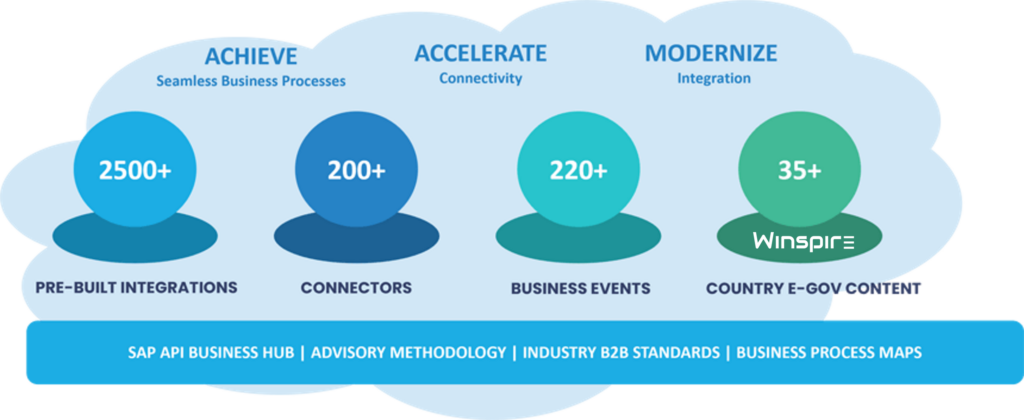Integration Service Modernization
Overview
Future of PO?
SAP PO will reach end of mainstream maintenance in 2027, extended maintenance will be till 2030, after which SAP will no longer provide support for the product. For critical business processes, it is important to migrate to SAP Integration Suite before this date to ensure ongoing support.
Increasing Complexity of Systems
With the rise of digitalization, organizations are using more systems to manage their business processes, resulting in an increasing complexity of systems. Integration helps to connect these systems and exchange information between them, reducing this complexity and streamlining business processes.
Growing Competition
The business world is becoming increasingly competitive, and organizations are looking for ways to differentiate themselves and improve their competitiveness. Integration helps organizations to improve their operational efficiency, streamline their business processes, and reduce costs, which can provide a competitive advantage.
Globalization
The increasing globalization of business is driving organizations to expand their operations into new markets, which requires the integration of systems and processes across different regions and countries. Integration helps organizations to manage this complexity and ensure that their operations are connected and aligned.
Rising Demand for Data
The increasing demand for data-driven decision-making is driving organizations to collect and integrate data from a growing number of sources. Integration helps organizations to gather, integrate, and analyze data from different systems, improving the quality and accuracy of their data.
Need for Collaboration
In today’s fast-paced business environment, organizations are looking for ways to collaborate more effectively with partners, suppliers, and customers. Integration helps organizations to exchange information and collaborate with others in a seamless and efficient manner
Integration complexity
Integrating various systems and applications can be complex and challenging, especially if they use different technologies and protocols.
Data quality and consistency
Ensuring data quality and consistency across different systems and applications can be difficult, especially if data is entered manually or if data validation rules are not well-defined.
Scalability
As businesses grow and the number of processes increase, it can be difficult to scale the PO solution to accommodate the increasing demands.
Maintenance and updates
Keeping the PO solution up-to-date and compatible with changes in underlying systems and applications can require significant effort and resources.
User adoption
Getting users to adopt and use the PO solution can be challenging, especially if it requires significant changes to their existing workflows and processes.
Security and compliance
Ensuring the security and compliance of sensitive data that is being processed through the PO solution is a major challenge.
SAP Integration Suite is a suite of solutions offered by SAP for the integration of SAP and non-SAP systems
It provides a variety of tools and technologies for connecting and exchanging data between different systems, helping organizations to streamline their business processes and improve the flow of information between different systems

Capabilities
Data Integration
The SAP Integration Suite provides tools for integrating data between different systems, including data mapping, data validation, and data transformation. This helps organizations to ensure that data is accurate, consistent, and up to date.
Use Case- A manufacturing company uses the SAP Integration Suite to integrate data from its production systems with its ERP system. By using data mapping and transformation tools, the company can ensure that production data is accurate and consistent, which helps to improve inventory management and production planning.
Process Integration
The SAP Integration Suite provides solutions for integrating business processes between different systems, including process automation, process orchestration, and process monitoring. This helps organizations to streamline their business processes and improve operational efficiency.
Use Case- A retail company uses the SAP Integration Suite to automate its order processing process. By using process automation and orchestration tools, the company can streamline its order processing process and reduce the time required to fulfill orders, which helps to improve customer satisfaction.
Application-to-Application (A2A) Integration
The SAP Integration Suite provides solutions for integrating applications, including web services, RESTful APIs, and cloud-based integration. This helps organizations to connect different applications and exchange information in a seamless and efficient manner.
Use Case- An insurance company uses the SAP Integration Suite to integrate its claims processing system with its policy management system. By using web services and RESTful APIs, the company can exchange information between the two systems in a seamless and efficient manner, which helps to improve claims processing efficiency.
Business-to-Business (B2B) Integration
The SAP Integration Suite provides solutions for integrating with partners, suppliers, and customers, including EDI (Electronic Data Interchange), XML, and AS2 (Applicability Statement 2) protocols. This helps organizations to exchange information with their partners in a standard and secure manner.
Use Case- An automotive manufacturer uses the SAP Integration Suite to exchange EDI messages with its suppliers. By using EDI protocols, the company can ensure that information is exchanged in a standard and secure manner, which helps to reduce errors and improve supply chain efficiency.
Cloud Integration
The SAP Integration Suite provides cloud-based integration solutions, including SAP Cloud Platform Integration, which allows organizations to integrate SAP and non-SAP systems in the cloud. This helps organizations to take advantage of the benefits of cloud computing, such as scalability and reliability, while maintaining secure and efficient integration processes.
Use Case- A healthcare provider uses the SAP Integration Suite to integrate its electronic health records system with a cloud-based patient portal. By using SAP Cloud Platform Integration, the provider can ensure that patient data is exchanged securely and efficiently between the two systems, which helps to improve patient engagement and satisfaction.
Event-Driven Integration
The SAP Integration Suite provides event-driven integration solutions, including SAP Cloud Platform Eventing, which allows organizations to trigger integration processes based on specific events. This helps organizations to respond quickly and efficiently to changes in their business environment.
Use Case- An e-commerce company uses the SAP Integration Suite to trigger email notifications to customers when an order is shipped. By using SAP Cloud Platform Eventing, the company can ensure that notifications are triggered automatically based on specific events, which helps to improve customer satisfaction and reduce manual effort.
Monitoring & Management
The SAP Integration Suite provides tools for monitoring and managing integration processes, including real-time monitoring, error handling, and process tracking. This helps organizations to ensure that integration processes are running smoothly and efficiently, and to quickly resolve any issues that arise.
Use Case- A financial services company uses the SAP Integration Suite to monitor its payment processing systems in real-time. By using real-time monitoring and error handling tools, the company can quickly identify and resolve any issues that arise, which helps to ensure that payment processing is efficient and reliable.
Increased efficiency and productivity
By integrating systems, applications and data sources, the SAP Integration Suite can streamline processes and reduce manual efforts, resulting in increased efficiency and productivity.
One example is Generali Group, a large insurance company. By using the SAP Integration Suite, Generali was able to integrate its various systems and applications, leading to a reduction in manual efforts and increased efficiency. The company reported that it was able to process claims faster and more!
Enhanced security and compliance
The SAP Integration Suite offers various security features and tools to ensure that data is protected and compliant with relevant regulations.
Improved data accuracy and consistency
The integration of data from different systems and sources can lead to improved data accuracy and consistency, reducing the risk of errors and improving overall decision-making.
A study by IDC found that organizations that integrated their data had a 50% lower error rate than those that did not. By using the SAP Integration Suite for data integration, organizations can reduce the risk of errors and inconsistencies in their data, leading to improved decision-making. (Source: IDC)
Improved agility and responsiveness
By integrating systems, organizations can respond to changing business needs more quickly and easily, leading to improved agility and responsiveness.
By using the SAP Integration Suite, Vodafone was able to integrate its systems and applications, leading to improved agility and responsiveness. The company reported that it was able to launch new products and services more quickly and respond to customer needs more effectively. (Source: SAP case study)
Better customer experience
The seamless integration of systems and applications can lead to a better customer experience, as customers can access the information they need more easily and quickly.
One example is Kärcher, a cleaning equipment manufacturer. By using the SAP Integration Suite to integrate its systems and applications, Kärcher was able to provide its customers with real-time information on product availability and delivery status. This led to a better customer experience and increased customer loyalty. (Source: SAP case study)
Increased competitiveness
The SAP Integration Suite can help organizations stay ahead of the competition by enabling them to integrate and manage their systems and data more effectively.








